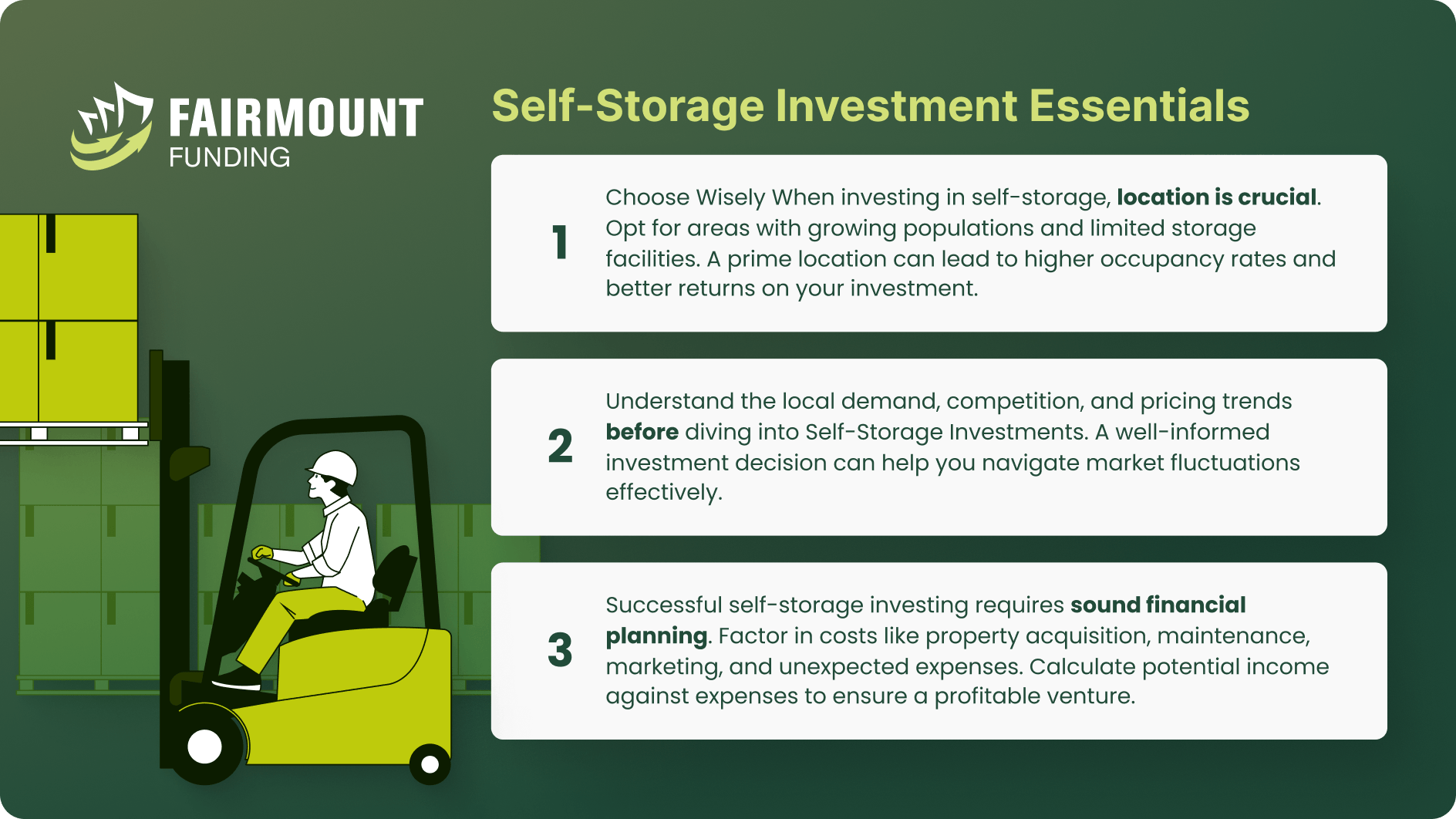
As urban spaces become more compact and living spaces more dynamic, the demand for additional storage continues to surge. The self-storage market is expected to increase to $72.15 billion by 2028.
This trend has propelled self-storage units into the spotlight, providing individuals and businesses with additional storage space. Meanwhile, this presents an opportunity for real estate investors to diversify their portfolios. The appeal lies in the asset’s ability to generate consistent rental income and its resilience during economic fluctuations. Amidst market volatility, self-storage investments proved that they can remain stable, attracting those who seek a reliable anchor in their investment ventures.
Whether it is the e-commerce entrepreneur seeking inventory warehousing or urban dwellers needing extra room, the demand for accessible storage solutions persists. However, there are factors that property investors must consider before investing in self-storage facilities.
What is self-storage investing?
Self-storage investing is when you fund a storage unit facility. Doing so allows you to cater to people and businesses looking for additional storage space.
There are several reasons they use a self-storage unit. This includes moving to a new or smaller space, keeping their belongings during a renovation, or storing items not integral to daily business operations.
Regardless of the reason and the length of rent, investing in storage units enables you to earn as long as your clients keep their belongings in your facility.
Different Types of Self-Storage Facilities
Self-storage facilities are classified into three groups, depending on age, location, and amenities. It is advisable to familiarize yourself with these classifications before making self-storage investments, as these can impact the ROI you can expect.
- Class A: These facilities or storage units were built within the last 15 years. They are in prime locations and offer premium amenities, leading to low turnover and high occupancy rates.
- Class B: These are self-storage facilities that are at least 15 years old and may lack some of the premium amenities. Hence, they can cost an average of $108 monthly.
- Class C: Old self-storage units not in prime locations belong to Class C. They have limited amenities, which explains the lower rental fee.
8 Factors to Consider Before Making Self-Storage Investments
When delving into self-storage investments, there are factors you should consider. These factors are pivotal in determining the potential success of your venture.
Location
The adage “location, location, location” holds especially true with self-storage facilities. A strategic location can significantly impact your self-storage facility’s demand and occupancy rates. Hence, opt for a site with strong visibility, accessibility, and proximity to densely populated residential or commercial areas.
Local Market
Thoroughly analyze the local market demand and competition. Identify any gaps in storage offerings and assess the saturation level of existing facilities. A well-researched understanding of the market can guide your pricing, marketing, and overall business strategy.
Facility Size and Amenities
Choose a facility size that aligns with the market demand and your storage unit investing goals. Consider the types of units and included amenities that cater to a diverse range of potential renters and dial in on the ones most important to them.
Security Measures
Prioritize security features like surveillance systems, gated access, and alarm systems. Safety is paramount for renters, and a secure facility can attract and retain tenants as it will give them peace of mind in their investment.
Financial Feasibility
Prepare a detailed financial analysis encompassing upfront costs, ongoing operational expenses, potential rental income, and projected return on investment (ROI). Remember to factor in vacancies and seasonal fluctuations.
Compliance
Familiarize yourself with local, state, and federal regulations that govern self-storage businesses. Ensure your facility meets all legal requirements, including rental agreements, insurance, and tenant rights. Ensuring compliance from the start will save you money and headaches later on.
Management
Decide whether you will self-manage the facility or hire a management company. Each option has responsibilities and considerations for staffing, maintenance, and customer service. And each style of management has its own pros and cons.
Financing Options
Explore various financing options, from traditional loans to hard money self-storage loans. Choose a financing structure that aligns with your financial capabilities and investment goals, as well as a lender that is willing to engage you as an equal business partner and values a long lasting and profitable relationship.
What makes self-storage investments profitable?
Across the United States, 38% of Americans rent self-storage. The reasons for using such facilities include relocating, needing more space at home, and downsizing.
Increased urbanization and improved economic outlook lead to new business growth in the self-storage industry. Additionally, the following makes self-storage investments profitable:
- Minimal upkeep. Unlike apartment complexes, storage units do not require aesthetic enhancements or emergency plumbing fixes. Your clientele seeks secure and dependable storage space for their belongings.
- Limited risks. Experiencing frequent tenant turnover is not a concern with self-storage establishments, as there is a continuous influx of individuals moving, downsizing, or seeking storage solutions. Thus, self-storage demonstrates greater resilience during economic downturns.
- Leverage affordable land. Another excellent thing about self-storage real estate investing is that it does not require substantial foot traffic or a prime location. Irregularly sized or less appealing land parcels, which often cost less, are enough to turn into a self-storage facility.
- Modest breakeven point. The expenses associated with self-storage investments are comparatively lower due to economic land acquisition and reduced emphasis on aesthetics and staffing. The breakeven period is shorter, allowing you to generate ROI quickly.
Self-Storage Investments FAQs
What makes self-storage unit investments a good idea?
Investing in self-storage can be attractive due to its unique stability and growth potential blend. The demand for storage space remains consistently high, driven by factors like urbanization, changing lifestyles, and the need for additional space.
Self-storage units offer a dependable source of rental income, often accompanied by favorable occupancy rates that tend to stay robust even during economic fluctuations. Additionally, the relatively low operational costs, reduced turnover, and flexibility in pricing contribute to the profitability of self-storage investments.
Which is better: Building my self-storage facility or buying an existing one?
Deciding between building a new self-storage facility or purchasing an existing one depends on various factors. Building from scratch grants you control over design and location, allowing customization to match your investment strategy. However, it demands higher upfront costs and a longer period to break even.
On the other hand, acquiring an existing facility can provide immediate cash flow and an established customer base. However, doing so might limit customization and involve unforeseen issues.
How much does it cost to start a self-storage business?
Building a self-storage business can vary widely based on location, facility size, land costs, construction expenses, and regulatory requirements. According to ProjectionHub, a rough estimate for a small self-storage facility with around 100 units could range from $300,000 to $500,000 in initial investment.
Larger facilities with more units and amenities can require several million dollars. These costs encompass land acquisition, construction, permits, marketing, staff, and operational expenses.
Diversify Your Portfolio With Self-Storage Investments
As urbanization continues and lifestyles evolve, the demand for accessible and secure storage solutions remains unwavering. This enduring demand, coupled with the industry’s ability to weather economic fluctuations, positions self-storage investments as a prudent choice for those seeking steady income streams.
Whether you are a seasoned investor looking to diversify your portfolio or a newcomer exploring real estate opportunities, self-storage investments present a versatile option. The industry’s low operational costs, limited turnover, and consistent demand provide a solid foundation for profitability. Moreover, the flexibility to choose between building anew or acquiring existing facilities allows for tailored investment strategies to align with your goals.
By carefully considering factors like location, market trends, and financial feasibility, you can confidently navigate the landscape of self-storage investments. As this market thrives, embracing the potential for long-term success within the self-storage industry is an enticing prospect for investors ready to unlock its promising possibilities.
KEY TAKEAWAYS
- Self-storage investing is when you fund a storage unit facility to cater to people and businesses looking for additional storage space while earning rental income.
- Increased urbanization and improved economic outlook are some of the reasons that starting a self-storage business can be profitable.
- By carefully considering factors like location, market trends, and financial feasibility, you can confidently navigate the landscape of self-storage investments.


